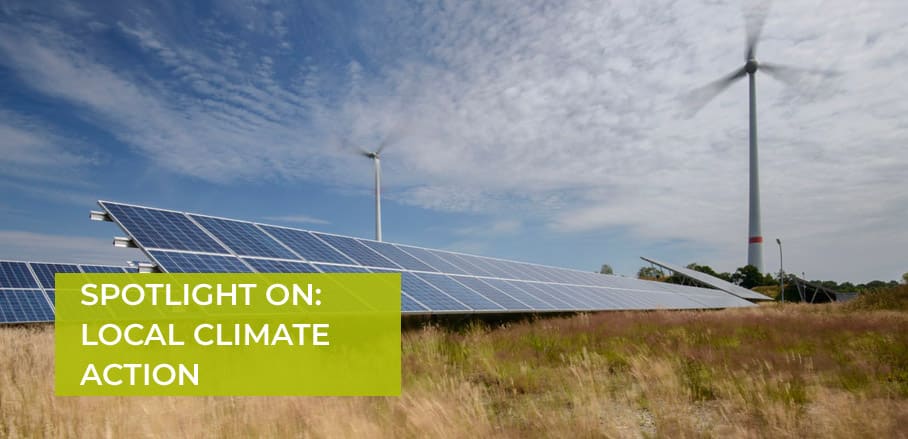Learning from a Frontrunner: German and U.S. Towns Partner on Climate Action
By Ulrich Gunka
Saerbeck, Germany’s award-winning climate protection project serves as a model for many other towns. Working with its citizens, the municipality transformed a former army ammunition depot into a bioenergy park that uses a mix of renewable sources to produce three times more electricity than the village needs, halving its carbon footprint in four years. Now it shares its knowledge with others, including the U.S. town of Morris, Minnesota. “Saerbeck is a true success story,” said Morris City Manager Blaine Hill. “In Saerbeck, we can learn to see things from a different angle.”
Sometimes climate protection starts with a cup of coffee—a reusable cup, not a disposable Styrofoam mug. When Blaine Hill, the city manager of Morris, Minnesota, visited the German town of Saerbeck, he was struck by the lack of disposable cups, not to mention the lack of gas-guzzling pick-up trucks. Hill and other visitors from Minnesota were drawn to the 7,200-inhabitant community by the award-winning Saerbeck climate protection project, which is an overall approach to sustainability comprising more than 150 climate efforts of different sizes and scopes. For many cities, [inlinetweet prefix=”” tweeter=”urbanet_info” suffix=””]Saerbeck serves as a model of local climate protection. “Saerbeck is a true success story,”[/inlinetweet] said Hill. “In Saerbeck, we can learn to see things from a different angle.”
Saerbeck: A climate community
Saerbeck’s goal is to be CO2-neutral by 2030. To that end, the municipality transformed a former army ammunition depot into a “bioenergy park” that uses a mix of renewable sources (including wind, solar, and biomass) to produce three times more electricity than the village needs. The park, which hosts seven wind turbines, two biogas plants, and a solar photovoltaic system with 24,000 modules, has already halved its inhabitants’ carbon footprint from 9.6 tons in 2010 to 5.5 tons in 2014.
But [inlinetweet prefix=”” tweeter=”urbanet_info” suffix=””]the real key to success lies with the citizens of Saerbeck: their willingness to support the climate protection project and to get involved with it[/inlinetweet], and especially to raise the awareness of the next generation. As Saerbeck’s climate community project manager, Guido Wallraven, puts it: “Everybody can build a photovoltaic system. What is more important is to anchor the idea of sustainability in the citizens.”
From the beginning, the municipality insisted on maximum transparency and citizen participation. This commitment paid off: Not a single citizen objected to the construction of the wind turbines. The photovoltaic system belongs to a local cooperative, Energie für Saerbeck, which includes 400 Saerbeck citizens. The cooperative owns one of the wind turbines, while another belongs to the community as a whole. The rest of the park was developed by local investors, so the value remains in Saerbeck. The municipality owns the site and maintains decision-making authority over the park.
The Climate Community Saerbeck is also a multi-generational project. Students have unique educational experiences in the bioenergy park, including an out-of-school program where children and adolescents conduct experiments and learn how sustainability works in everyday life.
Sharing the Saerbeck story
So how can Morris benefit from the Saerbeck model? About 250 kilometers west of Minneapolis, the town of Morris is about the same size as Saerbeck and is home to 5,200 residents and the University of Minnesota Morris. Since October 2015, both towns have been connected through the “Climate Smart Municipalities” partnership between the U.S. state of Minnesota and the state of North Rhine-Westphalia in Germany. This partnership pairs five Minnesotan and five North Rhine-Westphalian cities, including Morris and Saerbeck, to work together on renewable energy, energy savings, and energy efficiency.
The intensive exchange of knowledge—including regular site visits and Skype calls—is fundamental to this collaboration. Delegations from Morris and the University of Minnesota have been guests in Saerbeck on several occasions, most recently in January 2018. As part of a student project, Morris’ high school is seeking to install photovoltaic modules on its roof, just like Saerbeck’s comprehensive school. Following the example of the Gläserne Heizzentrale in Saerbeck, Morris and the university are planning to build a local district heating grid that uses biomass energy. Morris’ administration plans to evaluate the energy use of public buildings and develop energy efficiency measures.
At the moment, the transfer of knowledge and experience is mostly a one-way street, running from Saerbeck to Morris. “That’s simply because we set off ten years ago,” said Wallraven. Nevertheless, both Wallraven and Saerbeck Mayor Wilfried Roos have discovered new ideas from Morris for making Saerbeck’s agriculture more energy efficient. For example, the West Central Research and Outreach Center in Morris is studying ways to produce fertilizers using stored renewable energy. Saerbeck officials have also explored ways to make renewable electricity more competitive without state guarantees like Germany’s federal feed-in tariff for electricity from renewable sources.
The partnership between Morris and Saerbeck works well because Germany and the United States are both prosperous and highly industrialised countries. But what about less developed countries? This question was raised by delegates from the COP-23 World Climate Conference visiting Saerbeck in November 2017. The Saerbeck model is not transferable wholesale, as implementation depends on local and national contexts, especially economic conditions and energy industry frameworks. But Saerbeck can be a role model for a wide range of countries seeking to involve people in the community, engage stakeholders, and educate future generations.
Many thousands of visitors—including the governor of Fukushima, Japan—have come to Saerbeck to see how local climate protection works. The Saerbeck story isn´t only about renewable energies; it’s also about residents working together to forge a climate-friendly future and sharing their story with anybody who is interested in it.
[inlinetweet prefix=”” tweeter=”urbanet_info” suffix=””]Climate protection starts in everyday life. Sometimes it only takes a cup of coffee.[/inlinetweet]
Translated by Klaus Russel-Wells.
